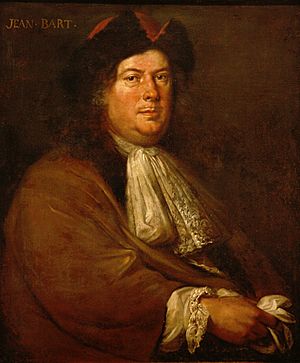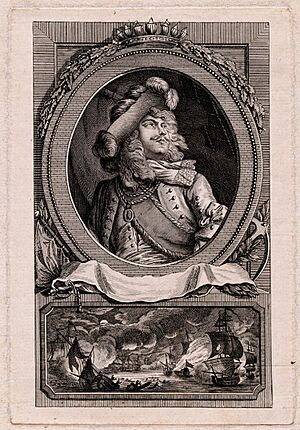Jean Bart facts for kids
Quick facts for kids
Jean Bart
|
|
|---|---|

Portrait by Mathieu Elias
|
|
| Born |
Jan Baert
21 October 1650 |
| Died | 27 April 1702 (aged 51) |
| Piratical career | |
| Type | Dunkirk privateer |
| Allegiance |
|
| Years active | 1672–1697 |
| Rank | Admiral |
| Battles/wars | Nine Years' War |
Jean Bart (born Jan Baert) was a famous French naval commander and a privateer. He was born on October 21, 1650, and passed away on April 27, 1702. A privateer was like a special kind of sailor who was allowed by their government to attack enemy ships during wartime. Jean Bart became a hero for his bravery and skill at sea.
Contents
Who Was Jean Bart?
Jean Bart was born in Dunkirk, a port city in France, in 1650. His family had a long history of working on ships. His father was a sailor, and his grandfather and great-grandfather were also important naval figures. Jean Bart likely spoke Dutch, which was common in his hometown at the time. His original name was Jan Baert.
Jean Bart's Early Adventures at Sea
When he was young, Jean Bart started his career in the Dutch navy. He served under a famous admiral named Michiel de Ruyter. This early experience taught him a lot about sailing and naval battles.
In 1672, a war began between France and the Dutch Republic. Jean Bart decided to join the French service. At that time, only people from noble families could become officers in the navy. So, Jean Bart became a captain of a Dunkirk privateer ship.

Jean Bart showed incredible courage and skill as a privateer. His actions were so impressive that King Louis XIV of France sent him on a special mission to the Mediterranean Sea. There, he continued to show his great talent.
Even though he wasn't from a noble family, Jean Bart's success was undeniable. He quickly became a lieutenant in 1679. He became a real threat to the Dutch navy and their trading ships.
Breaking Blockades and Saving Lives
One time, with only six ships, Jean Bart managed to break through a fleet of enemy ships that were blocking Dunkirk. He damaged many enemy vessels and safely brought a very important shipment of grain into the harbor. This act helped save Paris from starvation! Because of his amazing achievements, he quickly rose through the ranks, becoming a captain and then an admiral.
Key Battles and Victories
Jean Bart had his biggest successes during the Nine Years' War (1688–1697).
- In 1689, at the start of the war, he was captured by an English warship and taken to Plymouth as a prisoner. But just three days later, he and 20 other sailors managed to escape in a small rowboat and made it back to France.
- In 1691, he again slipped past the blockade of Dunkirk. He caused trouble for enemy merchant ships and even burned a Scottish castle and four villages.
- In 1693, he commanded a powerful ship called Le Glorieux. After a major battle, he found six richly loaded Dutch ships. He forced them to run aground and then burned them.
- In 1694, he achieved his most famous victory at the Battle of Texel. He captured a huge group of Dutch ships carrying grain, which, as mentioned, helped prevent a famine in Paris. For this great deed, King Louis XIV made him a noble.
- In 1696, he struck another blow against the Dutch in the Battle of Dogger Bank.
When the war ended with the Peace of Ryswick in 1697, Jean Bart's active service came to a close.
Family Life and Legacy
Jean Bart married Nicole Gontier in 1676. They had four children together before Nicole passed away in 1682. Their oldest son, François Cornil Bart, also became a vice-admiral, following in his father's footsteps.
Later, in 1689, Jean Bart married Jacoba Tugghe. They had ten children. He signed his marriage contract with his birth name, "Jan Baert."
Jean Bart died in Dunkirk on April 27, 1702, from a lung illness called pleurisy. He is buried in the Eglise Saint-Eloi in Dunkirk.
A Hero Remembered
Many stories are told about Jean Bart's courage and his straightforward personality. He became a very popular hero in the French Navy. He captured a total of 386 enemy ships and sank or burned many more.
The city of Dunkirk has honored Jean Bart's memory in several ways. There is a statue of him in a public square named after him. Every year during the Dunkirk carnival, local people kneel before his statue and sing a special song called the "Cantate à Jean Bart." He is truly seen as a local hero by the people of Dunkirk.
During World War II, much of Dunkirk was destroyed, but Jean Bart's statue survived.
Ships Named After Jean Bart
Over 27 ships in the French Navy have been named "Jean Bart" over the past 200 years. Some of these include:
- Jean Bart (1788) – A large 74-gun ship of the line.
- Jean Bart (1811) – Another 74-gun ship of the line.
- Jean Bart (1886) – A first-class cruiser.
- Jean Bart (1910) – A huge 23,600-tonne battleship, the first French Dreadnought.
- Jean Bart (1940) – A massive 50,000-tonne battleship with powerful guns. It was launched in 1940 but not fully finished until 1955.
- Jean Bart (1988) – An anti-aircraft frigate that was taken out of service in 2021.
Many smaller naval ships and privateer vessels have also carried the name "Jean Bart."
Images for kids
-
Painting of Jean Bart by Jean-Léon Gérôme (1862)
See also
 In Spanish: Jean Bart para niños
In Spanish: Jean Bart para niños





